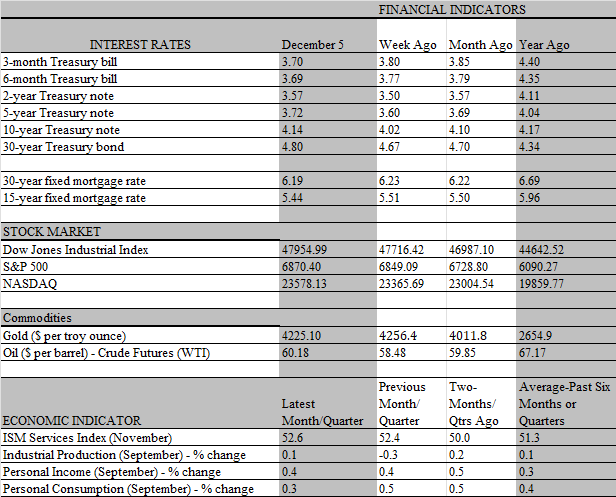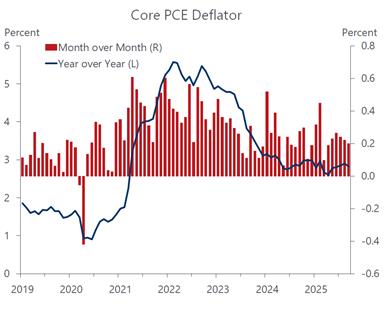
The backfilling of data continues apace, providing more evidence of the economy’s performance before the government shutdown. Nothing too revelatory is coming to the surface, as incoming information confirms general perceptions: Conditions were weakening, but the economy retained adequate muscle heading into the fourth quarter. We won’t be getting the official tally of third quarter GDP until January 8, when the BEA will be releasing the data. But the pattern shaping up for the period is coming into view. A decent, probably above-trend growth rate overall, punctuated by a softer ending.
The weaker exit to the third quarter reflected a pullback by consumers, the economy’s main growth driver. That was documented last week with the soft retail sales data for September and confirmed this Friday with the more comprehensive data on personal income and consumption. Total outlays on goods and services rose by 0.3 percent during the month, but the gain was all price-related, as real spending came in flat, following two months of solid increases which imparted a solid gain for the period. But in a clear sign of waning momentum, the September level of real spending stood only 2.1 percent higher than a year earlier, down from 2.6 percent in August and the weakest annual gain since January 2024.

But it’s doubtful that the loss of momentum carried over into the fourth quarter. Most industry reports and anecdotal evidence suggest that the holiday shopping season got off to a robust start, with seasonal purchases shaping up to be the strongest since 2021. As we are about to see for the third quarter, a strong start to the period matters, as it imparts heft to the average reading for the quarter. Still, the purchasing strength is conflicting with the bad vibes from consumers, as household sentiment remains in the dumps. The University of Michigan’s sentiment index, released Friday, did edge up in early December, but that may be more of a bounce related to the end of the shutdown, brightening expectations a tad, than any sense of improving conditions
It may be that the increasingly popular “buy now, pay later” promotions are stoking the purchases of struggling lower-income households. If so, that augurs for some retrenchment in coming months when it’s time for them to pay the piper out of stretched budgets. We note that real disposable income is barely keeping up with real spending, rising by a slim 0.1 percent in September. Over the past three months, the average annual gain in real DPI slipped to 2.1 percent, the slowest since June 2023. That said, the struggles of lower-income households are more than offset in the spending space by older and wealthier consumers, whose appreciating home values and stock portfolios continue to support discretionary outlays. The bifurcated consumer continues to be more of a feature than a bug driving the U.S. economy.
That bifurcation is not just confined to the household space, but in the business sector as well. We note that publicly traded corporations are delivering strong earnings results, propping up stock prices, but proprietors’ income, a component in the personal income report, fell again in September, the third setback in the past five months. One sign that mom-and-pop establishments are struggling is seen in their handling of their workforces. According to the latest ADP report, small businesses – those with less than 50 workers – continue to downsize, lopping off another 10 thousand employees in October, bringing total layoffs to 88 thousand over the last three months. Large firms, those with more than 500 workers on the books, added 151 thousand workers to their payrolls.

The downsizing of staff among small firms is unusual heading into the holiday season, when sales are the strongest of the year and many depend on those revenues to stay afloat. It’s possible that owners were overly pessimistic about how sales would turn out and were blindsided by the strength that has so far transpired. If so, there may have been a surge in catch-up rehiring in November, which may partly explain the surprising drop in initial claims for unemployment benefits late in the month. That said, the decision by small firms not to hold on to workers heading into the holidays may reflect cost pressures, reinforced by tariffs, more than sales expectations.
We suspect that the Fed will be inclined to prop up a sagging job market at its policy meeting next week and downplay the recent holiday-related strength in spending. That strength is likely coming from wealthier households, whose behavior is far less dependent on modest rate changes than on sudden unexpected changes in stock prices. The markets are pricing in a virtual certainty that a quarter-point rate cut is in the cards, and the Fed is averse to disappointing market expectations as it would risk disrupting the primary source of strength that is sustaining consumption. Odds are, however, that Fed chair Powell will once again send a strong message at the press conference that another cut in January is not a foregone conclusion.
While the Fed is laser focused on preventing a collapse in the job market, it is also keeping a wary eye on stubborn inflation. Even as the spending side slackened in September, prices did not. Both the headline personal consumption deflator and the Fed’s preferred inflation gauge, the core PCE deflator continued to run well above the 2 percent inflation target, with both notching a 2.8 percent increase over the past year. There is every reason to believe inflation will moderate next year, as most of the tariff passthrough is behind us, but the road to the 2 percent target is taking much longer than expected. Unless upcoming data on labor conditions deteriorate markedly before the January meeting, the Fed may well be patient and hold off on another easing move. Keep in mind that that households, including the struggling lower income cohort, will benefit from another fiscal thrust, thanks to a surge in tax refunds. If not used to pay down the holiday debt buildup, it could enter the spending stream and add some vigor to the economy.
